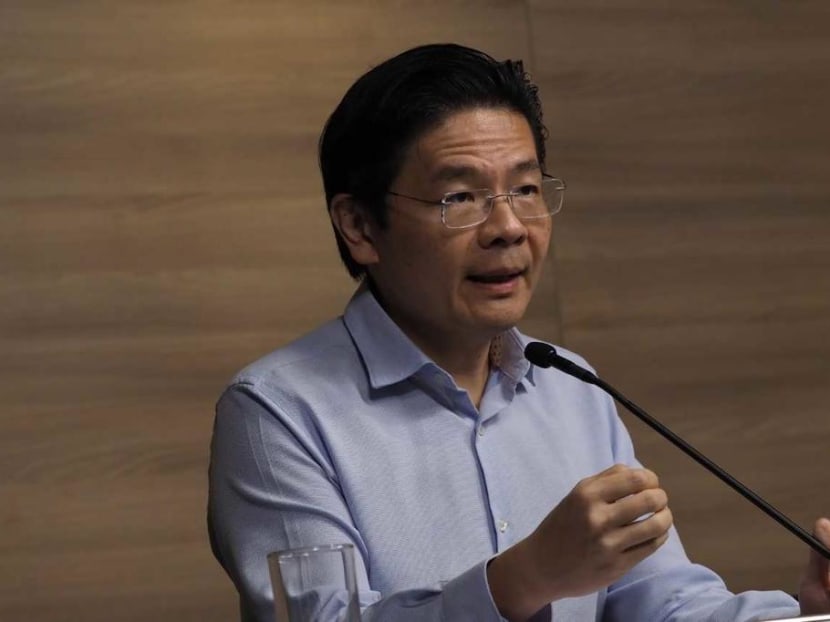Covid-19: Worrying trend of unlinked cases was why Singapore’s leaders activated ‘circuit breakers’
SINGAPORE — The worrying rise in the number of unlinked Covid-19 cases here had made it necessary to impose strict stay-at-home measures and other restrictions, Singapore’s leaders said on Friday (April 3).

National Development Minister Lawrence Wong, who co-chairs the government task force for Covid-19, said that the "major circuit-breaker" such as strict stay-at-home measures was designed to try to break the chain of transmission.
SINGAPORE — The worrying rise in the number of unlinked Covid-19 cases here had made it necessary to impose strict stay-at-home measures and other restrictions, Singapore’s leaders said on Friday (April 3).
These cases, which are spread locally and have no known connection to past cases, now make up around half of the new cases announced daily, Mr Lawrence Wong said. The Minister for National Development is the co-chair of the multi-ministry task force for Covid-19.
The numbers of these cases where the links are not known yet have climbed from single digits two weeks ago — or about a tenth of all cases then — to much more now, and this suggests the possible presence of Covid-19 cases lurking undetected in the population.
Health officials are saying that the situation can still be controlled and introduced stringent “circuit-breaker” measures that would empty non-essential workplaces, restrict people movement, and drastically scale down the operation of schools for at least a month — or two incubation cycles for the coronavirus — from April 7 to May 4.
Mr Wong said of the rationale for the move: “We do not want to wait for a situation where the cases rise sharply and then we get overwhelmed. We decided not to wait, but to make a decisive, pre-emptive move now and put in place this major circuit breaker to try and break the chain of transmission.”
As recently as March 31, Mr Wong said that a two-week lockdown is “no magic solution”, and that Singapore’s continued posture would be to apply extra brakes whenever the need arose.
However, since then, the number of new local and unlinked cases has raised eyebrows, with the country reaching a “critical stage” of the infection curve, he said.
There were 65 new cases on Friday — 56 had been infected within Singapore and out of these, there were 17 cases with no links to past cases.
“We are really in, as we have said repeatedly, for a long fight; even with these measures in place, we must expect the infected cases to continue to rise,” Mr Wong said at Friday’s press conference, which was shown live on television.
Prime Minister Lee Hsien Loong, in an address to the nation the same day, said that in order to ward off the uncertainty of a big outbreak and to bring the numbers down, a change of tack was needed.
“Looking at the trend, I am worried that unless we take further steps, things will gradually get worse, or another big cluster may push things over the edge,” Mr Lee said.
“I discussed this with the multi-ministry task force. We have decided that instead of tightening incrementally over the next few weeks, we should make a decisive move now, to pre-empt escalating infections,” he added.
Given the incubation period of the virus and the chance of asymptomatic spread, it takes around two weeks for the effect of containment measures to be felt, Mr Wong said.
“Our original thought was that we could perhaps take some time to see if the measures implemented, since last Friday, were having an effect in slowing down the spread of the virus. But we looked at the situation on a daily basis and we decided that we could not afford to wait any further because there are very worrying trends,” he said.
WHY WEREN’T MORE DRASTIC MEASURES TAKEN EARLIER?
Before Friday, certain segments of Singapore’s community had been urging school closures, complete bans on gatherings of any size, or a national lockdown in line with action taken by some other countries.
When asked if the authorities could have imposed these circuit breakers sooner, Mr Wong said that it all comes down to a judgement call based on the global and domestic situation.
“Certainly, we could have done this very much earlier but there is also a concern from public health experts, looking at all of these safe-distancing measures that we are referring to, if you were to put them in place too early, there may well be fatigue,” he said.
And when this fatigue sets in, people may gradually comply with these drastic measures, leading to the same eventual outcome while causing significant disruption to lives.
Mr Wong said: “Had we put them in place much earlier, we may very well still be in the same situation today three months later. And children will not have schools for three months longer.”
Compared with other countries that have imposed lockdowns or similar drastic measures, these measures for Singapore are occurring at a relatively early period in the Covid-19 infection curve.
“We have not reached a point where we are seeing many uncontrollable outbreaks. We are still in a phase where we are containing the virus. Many countries had moved to this set of measures that we just announced only after giving up and abandoning containment,” Mr Wong said.
Unlike these countries, Singapore has not given up on containment, he said. “We are still going all out to contact-trace and quarantine close contacts and try to stamp out every infected cluster.”
WHY AREN’T WE AT DORSCON RED?
Health Minister Gan Kim Yong reiterated this point in response to another question at the press briefing about why Singapore is not at Dorscon Red, despite the measures taken.
Dorscon (Disease Outbreak Response System Condition) is a colour-coded indication of how widely a disease has spread. Dorscon Red will mean several uncontrollable outbreaks and widespread community transmission, with contact tracing, containment and quarantine measures ineffective.
Singapore moved from Dorscon Yellow to Orange on Feb 7.
“We are not in Dorscon Red because we have not given up on contact tracing, not given up on containment and we are doing the opposite, stepping up our capacity in contact tracing and to go as far as possible to ringfence the transmission to contain it so as to reduce the number of new cases,” Mr Gan, who also co-chairs the task force, said.
“We are quite a distance from Dorscon Red, and we have to focus on our immediate task to increase our safe-distancing (measures) among our population.”
.embed-container { position: relative; padding-bottom: 56.25%; height: 0; overflow: hidden; max-width: 100%; } .embed-container iframe, .embed-container object, .embed-container embed { position: absolute; top: 0; left: 0; width: 100%; height: 100%; }Aside from boosting its ability to detect Covid-19 among the population, Singapore has also been ramping up its healthcare capacity, particularly in critical care.
In some countries, medical ventilators and intensive care unit (ICU) wards are scarce resources given the high numbers of infections they face. In Italy, doctors have had to prioritise whose lives to save due to a lack of ventilators, and other European nations are exploring converting snorkel masks into makeshift ventilators.
Associate Professor Kenneth Mak, the Ministry of Health’s director of medical services, said that Singapore has been expanding its healthcare capacity in phases as it anticipated an increase of the number of cases here.
There are now 25 Covid-19 patients in the ICU.
ICU wards can be converted from other wards due to the way hospitals are designed in Singapore, for instance.
The country is also expanding its step-down care capacity, Assoc Prof Mak said. This refers to a level of care below ICU but above a general ward.










